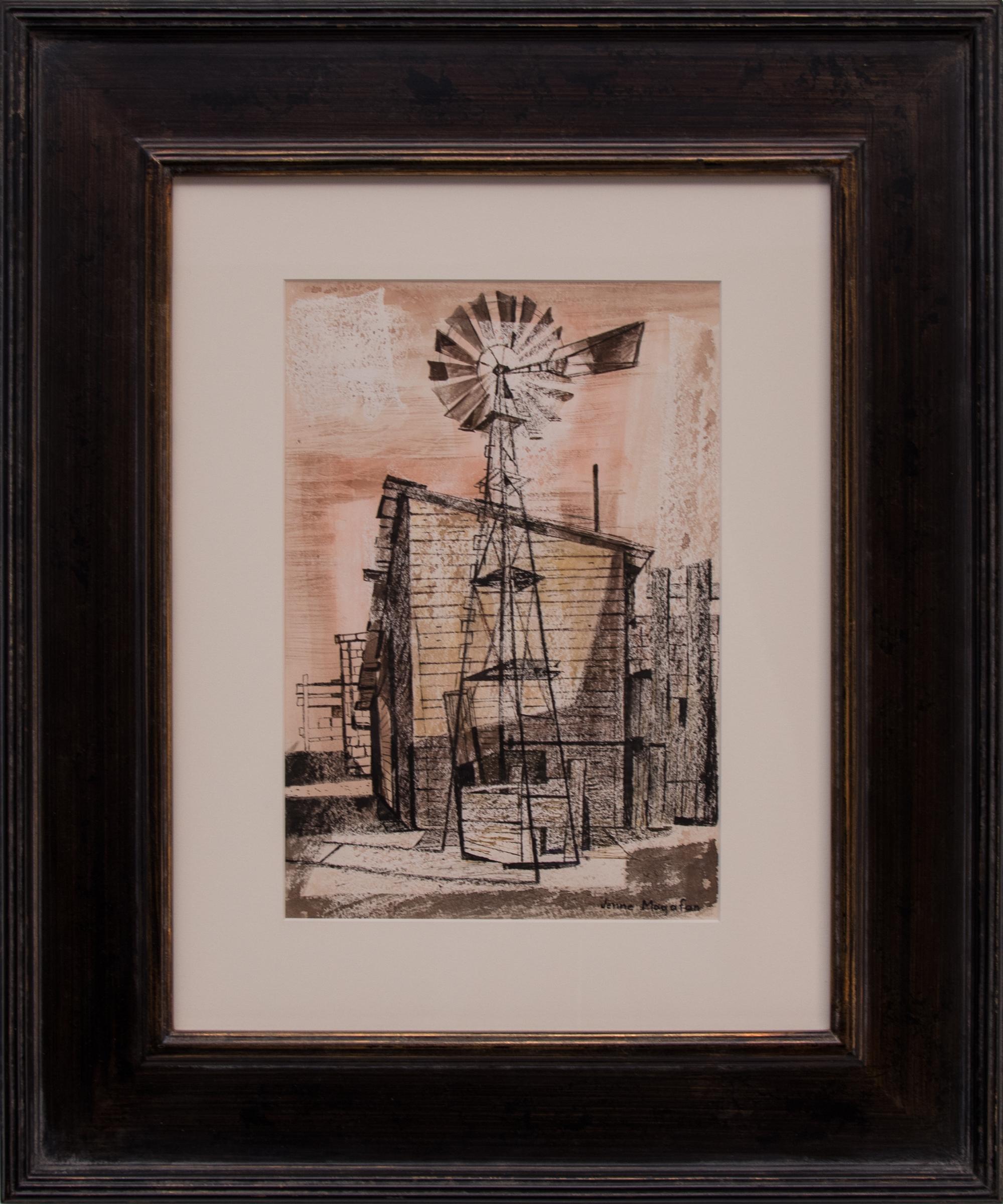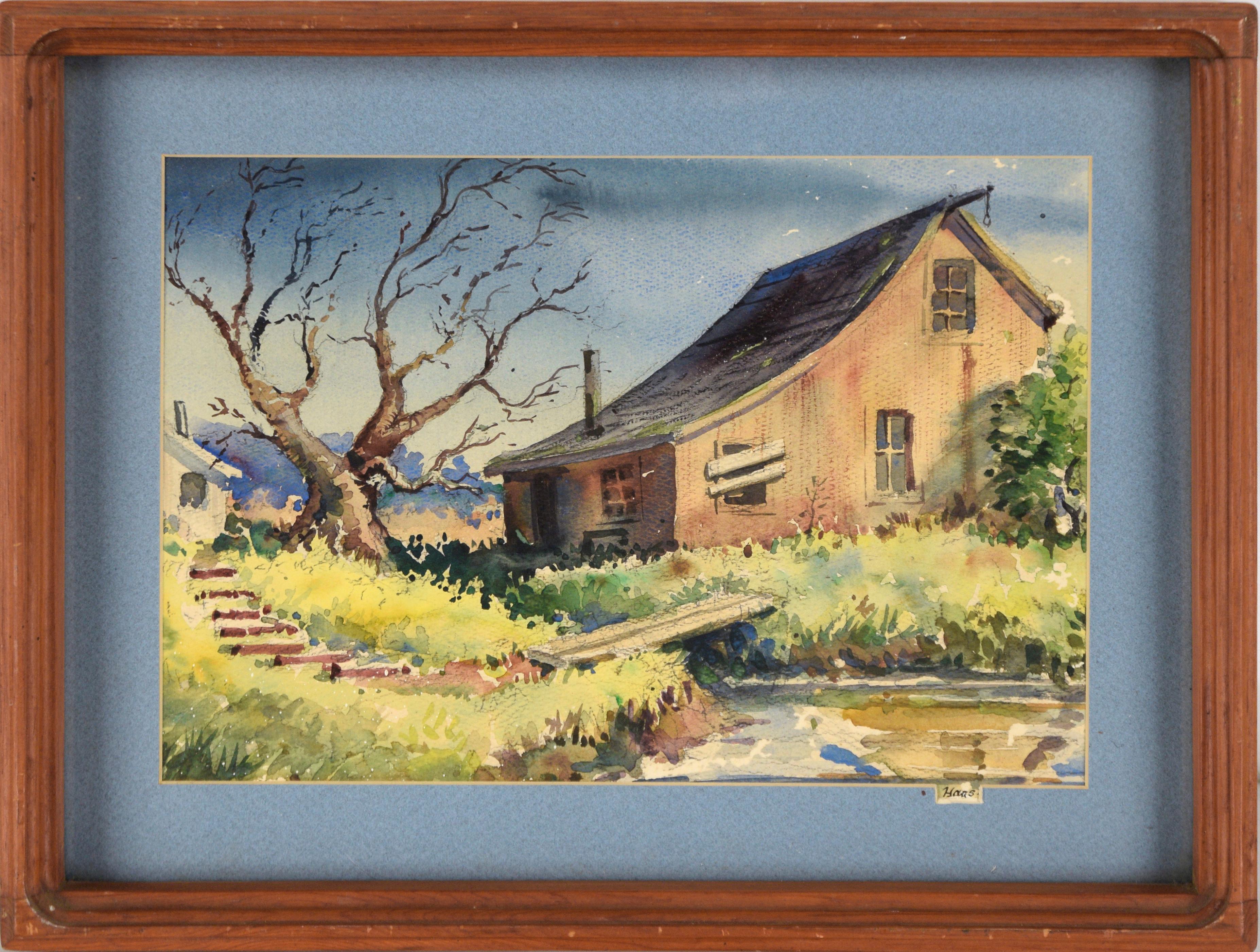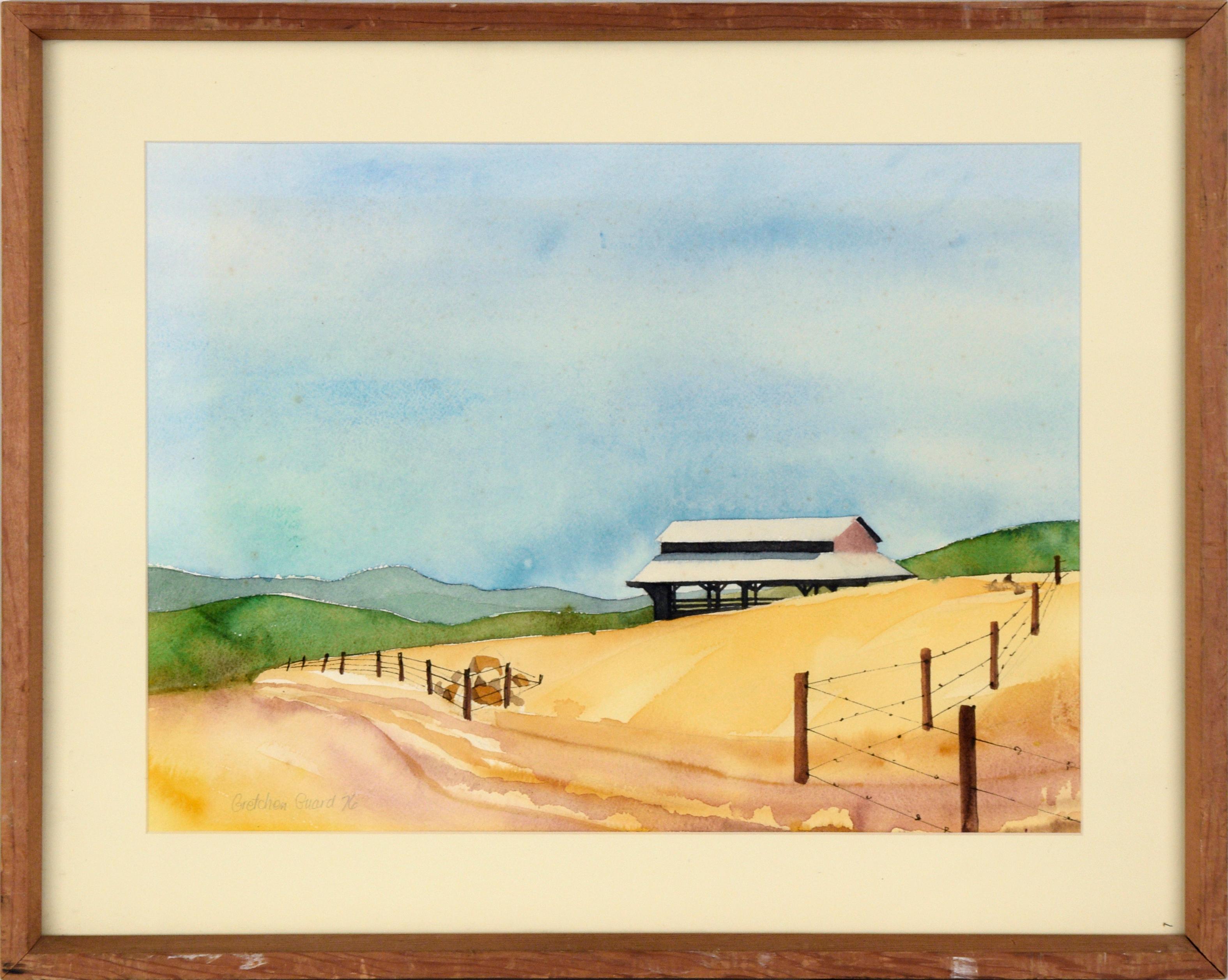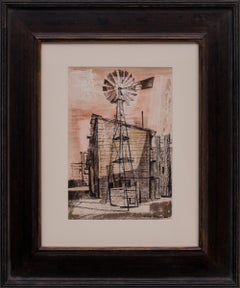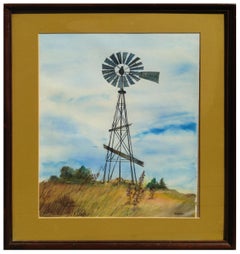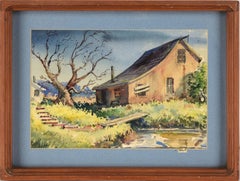Items Similar to 1930s American Modern Farm Landscape Watercolor with Barns, Windmill & Fields
Video Loading
Want more images or videos?
Request additional images or videos from the seller
1 of 17
Samuel Bolton Colburn1930s American Modern Farm Landscape Watercolor with Barns, Windmill & Fieldscirca 1935
circa 1935
$2,450
£1,818
€2,117.72
CA$3,410.42
A$3,797.81
CHF 1,976.55
MX$46,826.51
NOK 25,172.86
SEK 23,660.05
DKK 15,800.78
Shipping
Retrieving quote...The 1stDibs Promise:
Authenticity Guarantee,
Money-Back Guarantee,
24-Hour Cancellation
About the Item
This original watercolor painting by acclaimed American artist Samuel Bolton Colburn captures a quiet farmstead nestled in a mountain valley. Rendered with Colburn’s signature control and luminosity, the scene features traditional farm buildings, a windmill, and rolling fields bathed in natural light. The composition highlights his unique blend of American Scene realism with modernist sensibility.
Presented in a custom frame, the outer dimensions measure 22 x 28 ⅝ x 1 inches. Image sight size: 11 ¾ x 18 ⅜ inches. Archival materials used throughout.
About the Artist:
Samuel Bolton Colburn (1909–1993) was a prominent figure in mid-20th-century American art, known for his expressive landscapes and mastery of watercolor. San Francisco critic Alfred Frankenstein praised Colburn’s work, calling it “as fine an eye for the subtleties of watercolor as this country has produced since [John] Marin's heyday.”
Working primarily outdoors, Colburn developed a spontaneous, fluid painting style marked by clarity, control, and a modernist sensitivity. Though aligned with the American Scene movement of the 1930s and 1940s—which emphasized representational views of rural and urban America—Colburn’s art bridged realism and abstraction with sophisticated design and expressive color.
A member of the Monterey Peninsula's vibrant creative community, Colburn was associated with figures like John Steinbeck, Edward Weston, Ansel Adams, and Robinson Jeffers. His works, whether painted in California or on expeditions to Colorado and the American West, reflect a deep reverence for land, atmosphere, and form.
Colburn’s watercolors often featured dramatic light, open space, and thoughtful restraint—employing “white paper painting” techniques that let negative space become part of the composition. His paintings capture not only the landscape but the spirit and mood of place, time, and memory.
- Creator:Samuel Bolton Colburn (1909 - 1993, American)
- Creation Year:circa 1935
- Dimensions:Height: 11.75 in (29.85 cm)Width: 18.5 in (46.99 cm)
- Medium:
- Movement & Style:
- Period:
- Framing:Frame IncludedFraming Options Available
- Condition:
- Gallery Location:Denver, CO
- Reference Number:Seller: 258371stDibs: LU27310680602
About the Seller
5.0
Gold Seller
Premium sellers maintaining a 4.3+ rating and 24-hour response times
Established in 1979
1stDibs seller since 2013
289 sales on 1stDibs
Typical response time: 13 hours
- ShippingRetrieving quote...Shipping from: Denver, CO
- Return Policy
Authenticity Guarantee
In the unlikely event there’s an issue with an item’s authenticity, contact us within 1 year for a full refund. DetailsMoney-Back Guarantee
If your item is not as described, is damaged in transit, or does not arrive, contact us within 7 days for a full refund. Details24-Hour Cancellation
You have a 24-hour grace period in which to reconsider your purchase, with no questions asked.Vetted Professional Sellers
Our world-class sellers must adhere to strict standards for service and quality, maintaining the integrity of our listings.Price-Match Guarantee
If you find that a seller listed the same item for a lower price elsewhere, we’ll match it.Trusted Global Delivery
Our best-in-class carrier network provides specialized shipping options worldwide, including custom delivery.More From This Seller
View AllWindmill on the Plains, 1940s Watercolor & Ink Mixed Media Modernist Landscape
By Jenne Magafan
Located in Denver, CO
"Windmill on the Plains" is a captivating watercolor and ink on paper painting by 20th century Colorado artist Jenne Magafan. Created in the 1940s, this work depicts a large windmill...
Category
1940s American Modern Landscape Drawings and Watercolors
Materials
Paper, Ink, Watercolor
WPA 1940s Framed Figurative Village Landscape with Figures, Houses & Mountains
By Charles Ragland Bunnell
Located in Denver, CO
This evocative watercolor painting, titled The Way War First Comes (1940), was created by noted American artist Charles Ragland Bunnell (1897-1968) during the Depression era. The pie...
Category
1940s American Modern Figurative Drawings and Watercolors
Materials
Watercolor
Golden Cycle Mill Colorado WPA Mining Watercolor, 1940s Grayscale Artwork
By Charles Ragland Bunnell
Located in Denver, CO
Original 1940s grayscale watercolor painting by American artist Charles Ragland Bunnell, capturing a semi-abstracted view of the Golden Cycle Mill in Colorado Springs, Colorado. Painted in subtle shades of black and gray, this unique WPA-era landscape combines industrial subject matter with expressive, modernist style. A striking piece of American regionalist art from the mid-20th century.
The work is presented in a custom black frame.
Framed dimensions: 18" H x 19 ½" W x 1 ⅜" D
Sight size: 8 ⅛" H x 9 ⅝" W
The Golden Cycle Mining and Reduction Company, depicted in this piece, was a major part of Colorado's mining boom in the early 20th century. Located in Colorado City (now part of Old Colorado City), the mill played a significant role in the region’s gold production and industrial development.
About the Artist: Charles Ragland Bunnell (1897–1968)
Charles Bunnell was a pivotal figure in Colorado’s 20th-century art scene. He worked across multiple styles—from representational landscapes to fully abstract compositions—and was one of the few artists in Colorado to successfully embrace the evolving trends of Modernism, Surrealism, and Abstraction after WWII.
Bunnell studied under notable artists at the Broadmoor Art Academy, including Ernest Lawson and Birger Sandzén. His early works, including regional landscapes and mining scenes like this one, showcase a mix of American Scene painting and semi-abstract structure. He later became known for his bold experimentation with color, form, and geometry, producing both expressive oils and ink-watercolor series such as Black and Blue.
He participated in multiple New Deal art...
Category
1940s American Modern Landscape Paintings
Materials
Watercolor
Modernist Abstract Landscape Watercolor 'Old Mine and Houses, Cortez Colorado'
By Richard Ayer
Located in Denver, CO
This striking 20th-century modernist watercolor by Richard K. Ayers depicts a captivating scene of an old mine and houses in Cortez, Colorado. The artwork features a rich color palette of blue, green, gold, and brown, capturing the rugged beauty of the landscape with a unique, abstract perspective. Presented in a custom frame with all archival materials, the outer dimensions of the piece measure 36 ½ x 30 ½ x ¾ inches, with an image size of 24 ¾ x 18 ¾ inches.
About the Artist: Richard K. Ayers (1921–2003) was a talented artist who studied at Miami University...
Category
20th Century American Modern Abstract Paintings
Materials
Watercolor
$2,250 Sale Price
40% Off
1940s WPA Era American Modern Colorado Mountain Landscape Watercolor Painting
Located in Denver, CO
This original watercolor painting by American artist Edgar Britton captures the serene beauty of a Colorado mountain landscape. Created in 1946, this piece showcases soft, airy tones...
Category
1940s American Modern Landscape Drawings and Watercolors
Materials
Watercolor
20th Century Plein Air Impressionist Northern California Landscape, Farmhouse
By Jon Blanchette
Located in Denver, CO
Original Mid 20th Century Northern California Landscape Painting by Jon Blanchette (1908-1987). This vintage plein air style painting depicts a serene rural scene with a white farmho...
Category
Mid-20th Century American Impressionist Landscape Paintings
Materials
Oil
You May Also Like
Mid Century Windmill Rural Landscape
By H. Kendall
Located in Soquel, CA
Stoic watercolor painting of a tall windmill in a rural landscape by H. Kendall . Signed "H. Kendall" lower right. Presented in a yellow mat and wood f...
Category
Mid-20th Century American Impressionist Landscape Drawings and Watercolors
Materials
Paper, Watercolor
The Old Barn - Farmhouse Landscape in Watercolor on Paper
Located in Soquel, CA
Idyllic farmhouse landscape by California artist Edwin Haas (American, 1927-2010). A barn with a boarded window is the primary focus of this piece. It is seated in a lush landscape, full of grass, with a small stream running through the center. To the right of the barn is a bare oak tree, and steps can be seen leading to another building. A Sacramento artist...
Category
Mid-20th Century American Impressionist Landscape Drawings and Watercolors
Materials
Watercolor, Laid Paper
California Landscape with Farm
Located in San Francisco, CA
This artwork "California Landscape with Farm" 1943 is a watercolor on paper by noted California (German/American) artist Ernst Stolz, 1901-1989. It is signed and dated at the lower r...
Category
Mid-20th Century American Impressionist Landscape Drawings and Watercolors
Materials
Watercolor
California Farmhouse Landscape in Watercolor on Paper (Two Sided)
Located in Soquel, CA
California Farmhouse Landscape in Watercolor on Paper
Original watercolor painting of a farmhouse at the top of a hill by Bertram Spencer (American, 1918-1992). A small farmhouse si...
Category
1950s American Impressionist Landscape Paintings
Materials
Paper, Watercolor
$840 Sale Price
20% Off
Barn in the Rolling Hills, 1970's Landscape Watercolor on Paper
By Gretchen Guard
Located in Soquel, CA
Wonderful minimalist mid-1970's landscape watercolor of a simple barn on a hilltop by Gretchen Guard (American, 20th Century). The artist used clean lines and decisive areas of color to render the barn in crisp detail and make it pop from the soft landscape around it.
Signed "Gretchen Guard" and dated "76" lower left.
Displayed in a new cream mat and rustic wood frame.
Frame size: 17"H x 21"W
Image size: 12"H x 16"W
Gretchen Guard lives and works in Santa Fe, New Mexico and Cape Cod, Mass. She majored in studio art at Stanford University under Nathan Oliveira, Frank Lobdell and Mat Kahn. And at Santa Fe Art Institute with Wolf Khan...
Category
1970s Realist Landscape Drawings and Watercolors
Materials
Paper, Watercolor
$540 Sale Price
20% Off
Countryside - Original Watercolor on Paper by Pierre Segogne - 1950s
By Pierre Segogne
Located in Roma, IT
Countryside is an original artwork, realized by Pierre Segogne in the 1950s.
Hand-signed on lower right margin.
Mixed colored watercolor on paper.
This beautiful artwork represe...
Category
1950s Modern Landscape Drawings and Watercolors
Materials
Watercolor
$379 Sale Price
25% Off
